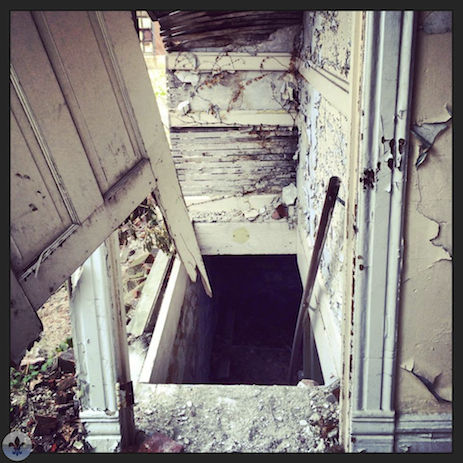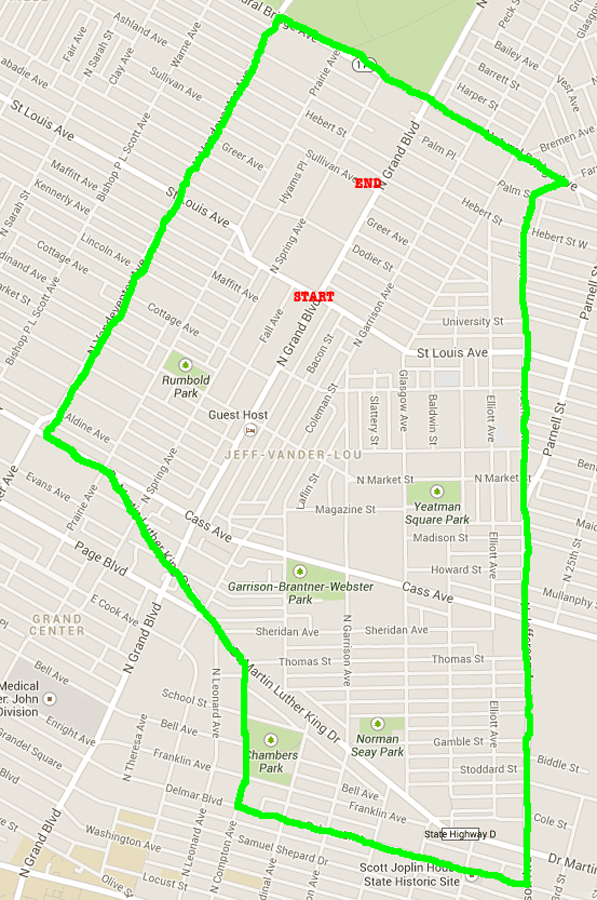photograph by Patrick Gioia
No doubt, Old North St. Louis has become synonymous with redevelopment on the city’s blighted north side, but Old North is not the only historically significant neighborhood worthy of a renaissance (nor are all north side neighborhoods “lost”). Once home to Sportman’s Park, JeffVanderLou (originally Yeatman) was a community woven together by baseball. Still, “America’s Pastime” was not the neighborhood’s first industry; close to the downtown warehouses, manufacturing was the major contributor of jobs both before and after the Stadium. Additionally, JVL burgeoned into a vibrant African-American community whose important contributions are still felt. Today, much of the iconic architecture has unfortunately been leveled (including the once resplendent manses and apartments near North Grand), but some very interesting structures and ornamentation do remain.
photograph by Jason Gray
photograph by Amanda Krebel
photograph by Ann Aurbach
Sportsman’s Park, 1945; from St. Louis and Its Streetcars by Andrew Young
In 1881, the “oldest ballpark in America” was constructed just north of the Yeatman neighborhood (historically bounded by Delmar, Jefferson, Grand, and St. Louis), which was an area already host to several manufacturing industries. In the time that the baseball stadium stood, more games had been played there than in any other major league park; Sportsman’s Park did so by hosting two professional teams, the American League’s St. Louis Browns and the National League’s St. Louis Cardinals. In addition, the Park hosted ten World Series, three All Star Games, and observed the pounding cleats of many hometown greats, such as, Stan Musial, Bob Gibson, and Lou Brock.
In 1915, St. Louis city passed a controversial Segregation Ordinance which declared that Whites should live in areas seperate from Blacks, and an expanded Yeatman became known as the city’s “Negro District”. Although a Supreme Court decision would overturn this ordinance a mere two years later (in a case against a similar ordinance involving Louisville, Kentucky), the practice continued unofficially for many decades. Upon the neighborhood, this had important and lasting effects, some positive (Yeatman became a center for the African-American community) and some negative (lingering racism, and the anxiety bred by it, limited the neighborhood from ever recapturing its full significance when industries eventually began to leave; a contrast to more integrated neighborhoods further south). Through the 1920’s though, Yeatman was a vibrant neighborhood humming with activity. Into this climate, the Carter Carborateur manufacturing plant was constructed in 1930. The massive facility loomed next door to Sportsman’s Park, and subsequently anchored the neighborhood’s economy until its closure in 1980. It is estimated that more than 3,000 employees worked inside the factory.
photograph by Mandi Gray
photograph by Amanda Krebel
photograph by Amanda Miller
photograph by Scott Jackson
In 1966, the last crack was heard from a baseball hitting a bat at Sportman’s Park (renamed Busch Stadium in 1953). In that year, baseball moved from the neighborhood into a brand new facility downtown. Also in that year, a local man named Macler Shepard was leading a fight against city-ordered demolitions which were beginning to occur in Yeatman. Citing a Federal Policy protecting urban renewal, Shepard successfully campained to save many buildings, ranging from single family residences to industrial plants. That year, he founded JeffVanderLou Incorporated, a community organization charged with preserving the neighborhood. His decision to rename the area JeffVanderLou was an apparent reference to a problem he observed; when outsiders came to visit (ostensibly to see baseball games), they drove or took the streetcars ambling down the main thoroughfares, Jefferson Avenue, Vandeventer Avenue, and St. Louis Avenue. He felt that this limitation of access inhibited economic redevelopment.
photograph by Dan Henrichs Photography, St. Louis
photograph by Scott Jackson
photograph by Ann Aurbach
photograph by Dan Henrichs Photography, St. Louis
Shepard was not the only advocate for JVL. In 1948, a former seamstress from Carondelet, named Lillie Velma Pearson, opened up a small grocery store on Garrison and Sheridan. The location that she chose was curious, considering that the site’s previous business, which failed, had also been a grocery store. Nonetheless, at Tillie’s Corner, Pearson offered much more than standard grocery fare. For the next 40 years, “Miss Tillie” (unique as a female, Black business owner in St. Louis) inspired her customers and her community. Tillie’s Food Shop reamained steadfast in the neighborhood even as it deteriorated and became riddled with crime, which was important because it demonstrated her investment to her neighbors. The shop eventually grew to become an informal community center (with associations ranging from a nearby PTA to the NAACP), a safe place in the neighborhood for residents to unify. Lillie maintained longer than normal business hours as well, which meant that customers could stop by after work (a problem of circumstance for many blue-collar workers). In 2006, Pearson passed away, leaving the property comprised of three brick townhouses, dating from just after the Civil War, to Carla Pearson Alexander, a grandchild who is currently seeking to open a tutoring center and museum on the site.
photograph by Jason Gray
photograph by Kristie Ferreira
photograph by Dan Henrichs Photography, St. Louis
photograph by Theresa Harter
photograph by Chris Naffziger
photograph by Kristie Ferreira
Today, JeffVanderLou is a neighborhood in flux, it has fallen so far that the only direction left to travel is up. In 1966, the neighborhood’s population reached a peak of 72,000, which has since declined to 5, 557 in 2010. Sportsman’s Park has been levelled, and a Boys and Girls Center stands in its place (positive if not for the historic structure it replaces). The former Carter Carborateur plant stands as a hulking empty mass over North Grand Avenue; its presence polluting both the spirit and the bodies of residents (it was declared an EPA Superfund site, and is fenced off). All throughout JeffVanderLou, buildings that would be treasured, historic properties in other neighborhoods stand in varying states of collapse. That said, there are forces working to revitalize, albeit slowly. On our trip, we met several individuals, coming out of their homes or stopping on their way to work to greet us, who, it should be pointed out were among the friendliest and most forthcoming people we’ve come across in any previous Flood. For me at least, it just goes to show that perceptions are damned poor indicators, and that there is real hope left in the still beating heart of this once vital body.
photograph by Mandi Gray
photograph by Scott Jackson
Our endpoint was supposed to be Bing Lau Chop Suey (on the map), but they were mysteriously closed when we were ready to eat. No worries though, we went slightly out of the neighborhood to the eponymous Sweetie Pie’s Upper Crust, which was amazing. Fried catfish was served along with candied yams, peach cobbler and pecan pie, and everyone left with a big smile and a full stomach.
photograph by Dan Henrichs Photography, St. Louis






























[…] like nearby JeffVanderLou, The Ville was a neighborhood shaped by the segregation that gripped St. Louis in the early 20th […]
[…] the neighborhoods surrounding Fairgrounds Park (O’Fallon, Fairground, Greater Ville, and JeffVanderLou) became increasingly neglected. Today, this neglect is easily visible in the Park, taking the form […]
[…] St. Louis Hills is an answer to the question, “What happened to places like The Ville and JeffVanderLou?” That said, there is very little not to like about this place, while strolling Francis Park […]